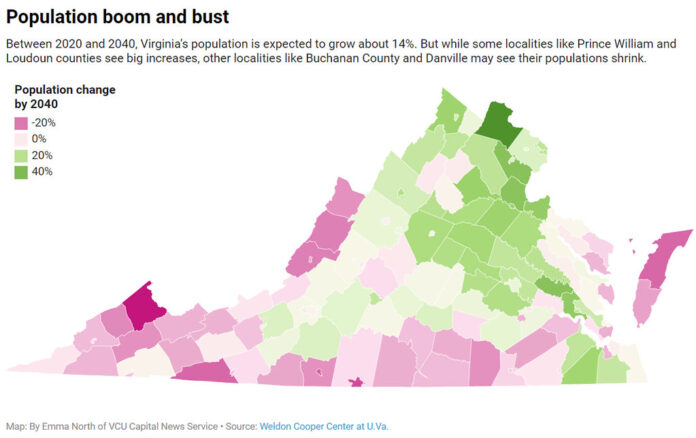“More and more people are relocating to Highland County, Virginia, everyday!” the county’s website says.
Online, local officials offer resources and encouragement for people to relocate to Highland County, the most sparsely populated in Virginia. A brochure urges readers to consider Highland’s “elevated lifestyle.”
But Highland County faces an uphill battle in attracting new residents. Demographers at the University of Virginia predict that the county’s population, now about 2,260, will drop 17% over the next two decades.
Of the state’s 133 cities and counties, U.Va.’s Weldon Cooper Center for Public Service projects that 53 will lose population by 2040. Most of those shrinking localities are in south, southwest and western Virginia.
“These areas are losing population every time the population is counted,” said Augie Wallmeyer, author of the book “Extremes of Virginia.”
“With a few minor exceptions, they just don’t have what it takes to retain people or attract new people.”
Many of the localities projected to lose population offer tranquility, clean air and beautiful views, but they lack job opportunities. Some also lack high-speed internet access that businesses need.
Wallmeyer said rural areas may lack sufficient health care and educational opportunities as well.
The state has implemented programs such as GO Virginia to encourage the growth of high-paying jobs throughout the commonwealth. Community colleges also are offering more job training programs. But Wallmeyer said there has been a lack of coordination among efforts to address problems in rural counties.
“Without coordination, you may find, for example, that GO Virginia might find a way to attract jobs to a county. But if the educational opportunities are very limited or if there is no good health care nearby or a terrible drug abuse problem or no amenities like Starbucks and that sort of thing, the effort fails,” Wallmeyer said.
The available workforce in rural counties becomes even smaller after factoring in age.
In an analysis of the data, Shonel Sen, a research and policy analyst for the Weldon Cooper Center’s Demographics Research Group, said that by next year, more than 30% of the residents in rural counties like Highland are expected to be over 65. That is double the statewide proportion of people over 65.
By 2040, people over 65 would make up more than 35% of the population of Highland and Lancaster counties, according to the center’s projections.
Having so many residents at retirement age subtracts from the available workforce. An aging population also creates a greater demand for health care, which many rural areas are struggling to provide.
The population trends affect not just the economy but also politics, Wallmeyer said. As rural counties shrink, so does their legislative representation. This makes it difficult to make their issues a priority at the state level.
“It bodes ill for people in those areas who think the political system can fix their problems,” Wallmeyer said.
The Demographics Research Group predicts that while parts of Virginia face drastic population losses, other parts will grapple with dramatic population gains. Overall, the state population will grow 14%, to almost 10 million, by 2040, the projections show.
Sen pointed out the “significant rural-urban divide” in Virginia. She noted that currently, 70% of the state’s residents live in the three largest metropolitan areas (Northern Virginia, Hampton Roads and the Richmond area) and only 12% live in non-metro areas.
By 2040, the demographers predict, Loudoun County would grow 55%, to almost 670,000 residents — adding the equivalent of the current population of Richmond. Loudoun would rise from being the state’s fourth most populous locality to the second, behind only Fairfax County.
The data also project high growth in other localities in Northern Virginia (such as Prince William and Stafford counties) and between Richmond and Williamsburg (New Kent and James City counties).
At the same time, the number of residents likely will decrease in rural areas. For instance, the center predicts that Buchanan County will lose almost a third of its population, going from more than 21,000 residents to about 14,500. The group’s data suggest that the populations of Danville and Martinsville, as well as Accomack and Grayson counties, will decline by more than one-fifth.
By Emma North / Capital News Service

